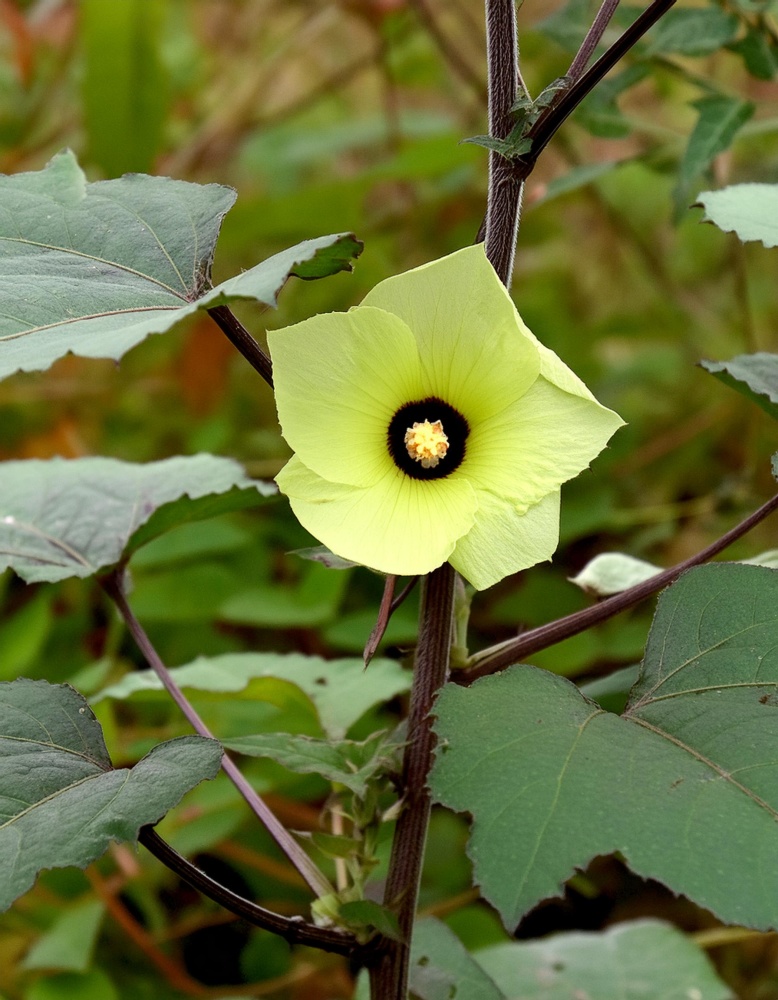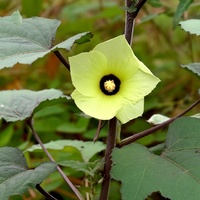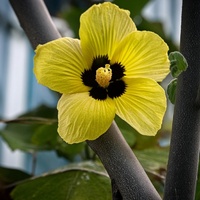Common name: Ambrette
Other common names: Musk mallow, Musk okra, Musky seeded hibiscus, Ornamental okra, Tropical jewel hibiscus, Wild okra
Description
Ambrette is an Okra (Abelmoschus esculentus) relative originating from India and cultivated for its seed, which yields a valuable essential oil.
The main centres of cultivation are its native India, the Seychelles islands, Nosy Be island in Madagascar, El Salvador in Central America, Martinique in the Caribbean and Ecuador and Colombia in South America.
An annual undershrub, it is typically 1 to 1.5 m (3 to 5 ft) tall with an erect, semi-woody main stem and slim stems branching off all around, all of which have a covering of fine hairs.
Leaves are deep green, large, up to 20 cm (8 in) long and even wider, varying in shape but usually palmate with shallow or deep lobes, toothed margins and coated with fine hairs.
The flowers are hibiscus-like with yellow petals and purple centres. They are followed by five-ridged seedpods, similar in appearance to okra but are shorter and wider and, like other parts of the plant, are finely haired. When mature, they contain many small, greyish-red, sometimes greenish, flat kidney-shaped seed.

Flower
Use
An essential oil traded as 'Musk oil' or 'Ambrette Seed Oil' is extracted from the seed. The oil is traditionally extracted by steam distilling the whole or crushed seed. Distillation, however, is slowly being replaced by new supercritical carbon dioxide extraction technology, which allows extraction at low temperatures with a less damaging effect on the oil.
The oil is highly valued in perfumery and is sought after as a flavouring agent for various products, including branded chewing tobacco, alcoholic beverages such as liqueurs, vermouth and bitters and some baked goods and sweets. It is a clear, light to dark yellow liquid with a distinctive, long-lasting floral-musky, wine- or brandy-like aroma and flavour. In perfumery, it is used in high-quality men's fragrances such as 'L' Egoistie by Chanel and 'Heaven' by Chopard.
Tinctures, or water-based liquid extracts, are also prepared from the seed and are used in combination with the oil as a flavouring component in the manufacture of branded vermouth and bitters products.
Seed production in commercial operation averages around 900 kgs per hectare per season. With an oil content of 0.2 to 0.6%, yields are 1.8 to 5.4 kgs of oil, the equivalent of 1.6 to 4.8 lbs of oil per acre.
Health use
The seed has value in traditional Indian or Ayurveda medicine for preparations to treat stomach and urinary ailments and nervous debility. In Chinese medicine, they are used in the treatment of headaches.
Climate
Grows naturally in humid subtropical and tropical lowland to mid-elevation climates, generally areas with annual lows of 13 to 25°C, annual highs of 23 to 35°C and annual rainfall of 800 to 2500 mm.
Growing
Ambrette is grown from seed sown in prepared soil at the start of the rainy season. The plants are then tended until they flower and develop fruit, about four to five months after the seed are sown.
Growth performance and disease resistance is best on free-draining loam, sandy-loam and loamy-sand soils of a mildly acid to slightly alkaline nature, generally with a pH of 6.0 to 7.5, and on sites with full sun exposure.
The seedpods are harvested when they are mature and have begun to turn from green to brown. Then they are strewn on a flat, hard surface in the shade where they are left to dry until they split open and release their seed. Afterwards, the seed are collected for processing or are bagged for shipping to a processing facility.
Problem features
Each plant bears many seedpods containing many small viable seed that are easily dispersed when the seedpod matures and splits open. It is recorded as an invasive species in at least one reference publication, a term reserved for the most serious weeds of the environment and agriculture.
The fine hairs on the plant and seedpods are an irritant to the skin in some people.
Where it grows
References
Books
-
Adams, C. D. 1972, Flowering plants of Jamaica, University of the West Indies, Mona, Greater Kingston
-
Dastur, J. F. 1964, Useful plants of India and Pakistan : a popular handbook of trees and plants of industrial, economic, and commercial utility, 2nd ed., D. B. Taraporevala Sons, Bombay
-
Farooqi, A. A. & Sreeramu, B. S. 2004, Cultivation of medicinal and aromatic crops, Hyderabad University Press, Hyderabad
-
Fawcett, W. 1891, Economic plants, An index to economic products of the vegetable kingdom in Jamaica, Jamaica Government Printing Establishment, Kingston
-
Groom, N. 1997, The new perfume handbook, 2nd ed., Blackie Academic & Professional, London
-
Guenther, E. & Althausen, D. 1948 to 1952, The essential oils (6 volumes), Van Nostrand Publishing, New York
-
Khan, I. A. & Abourashed, E. A. 2010, Leung's encyclopedia of common natural ingredients : used in food, drugs and cosmetics, 3rd edition, Wiley Publishing, Hoboken, New Jersey
-
National Research Council (Board on Science and Technology for International Development) 2006, Lost Crops of Africa: Volume II: Vegetables, The National Academies Press, Washington D.C.
-
Oyen, L. P. A. & Nguyen X. D. 1999, Plant Resources of South-East Asia (PROSEA) 19 : Essential-oil plants, Backhuys Publishers, Leiden
-
Parrotta, J. A. 2001, Healing plants of peninsular India, CABI Publishing, Wallingford, Oxfordshire
-
Randall, R. P. 2002, A global compendium of weeds, R.G. and F.J. Richardson Press, Melbourne
-
Roecklein, J. C & Leung, P.S. 1987, A Profile of economic plants, Transaction Books, New Brunswick, New Jersey
-
Seidemann, J. 2005, World spice plants: economic usage botany taxonomy, Springer-Verlag, Berlin



